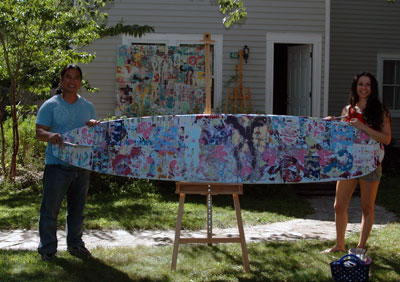
The action-packed abstract paintings have been hard to miss. Since July, groupings of them have been making appearances on the front lawn of a house in Sag Harbor near Mashashimuet Park.
The large canvases could be seen leaning against a tree, the house and ornamental bushes several days a week. A surfboard was the “canvas” for one of these abstracts, which typically surround an artist with paint brush in hand.
What passersby are witnessing is a slice of an artist’s life. The paintings are works in progress made by two artists who create works together. The two work quickly, inspired by electronic dance music, transferring paint applied to forms onto the canvas. Drips, spills and gestural strokes are part of the multi-layered mix. Paintings in a series are created simultaneously, so energy moves freely from canvas to canvas.
The art is being made by Yong Jo Ji and Anna Atanasova, a husband-and-wife team determined to make their mark on the art world.
Sometimes they work simultaneously on the same canvas; other times they develop the paintings solo.
The move to paint outside was a practical one—soaring temperatures made their upstairs studio an uncomfortable place to work. Taking the painting outside made perfect sense, the couple said. “We’re full-time artists,” Ms. Atanasova said. “We paint every day. This is what we do.”
The unusual collaboration by Mr. Ji and Ms. Atanasova followed swiftly after their first meeting around three years ago. Mr. Ji was a successful artist with a sprawling Chicago studio and representation for his encaustic paintings at galleries in different states. What brought them together was electronic dance music.
A shared passion for the driving beats, repeating rhythms and computerized sound pulses geared for dancing separately drew Mr. Ji and Ms. Atanasova to a techno dance club in Chicago. Their first date shortly after they met there uncovered another shared passion—painting. Mr. Ji invited Ms. Atanasova to his studio to see his work. Though she had never painted before, Mr. Ji sensed a latent talent. He gave her some acrylic paints and a brush.
Ms. Atanasova couldn’t stop painting. The pair fell in love and embarked on a life together.
Unlike most painters, Ms. Atanasova didn’t want a canvas of her own. She enjoyed making acrylic artwork with Mr. Ji. And Mr. Ji found beauty and a new type of energy in their collaboration. He continues to make encaustic abstract paintings on his own, along with the colorful, energetic acrylic paintings the couple make together. The jointly created works are the ones displayed outside the couple’s Sag Harbor home.
The canvases feature swirls of color, painted shapes, drips, gestural lines and sometimes collaged images. Over the last several years, the two have developed a language of repeating symbols for themselves. Symbols and images are created by applying paint to cardboard stencils or objects like bottles, cutlery, bubble wrap and plastic to create texture. The painted stencils or objects are applied gently to the canvas. Imagery includes abstract flowers, a kissing couple, circular swirls, an oval, a seated Buddha and others.
The recurring symbols are not meant to be deciphered like Egyptian hieroglyphics that conjure layers of history obliterated and rebirth. Instead, the art is meant to be viewed in a non-narrative way, the couple said. It is designed to invoke something else: the joy and passion they find in computerized music. They always listen to electronic music while painting and the type of music can influence the color palette and the way the paintings unfold, both artists said.
The artwork offers a visual simulation of the techno music they love and is rendered in the tradition of “pure painting” reminiscent of the approach of Wassily Kandinsky (1866-1944). Electronic music is marked by recurring beats and rhythms. While no two songs are exactly alike, many similarities carry from track to track within types and categories of music that is typically heard at raves. The paintings take a similar tack, with colors and imagery recurring in their work, though each painting is obviously an original.
Working on paintings together means that egos cannot enter into the mix. It is the chemistry between the two and the merging of their individual visions that makes the paintings work, Mr. Ji said. Nor is there anything particularly new about having two artists working together to make singular pieces of art.
Mr. Ji and Ms. Atanasova hope their work will become recognized alongside pieces by other famous collaborating artists from around the world. They cited the Zhou brothers, ShanZuo and DaHuang, originally from China and now longtime Chicago residents; husband and wife Eric and Heather Chanschatz, who are represented by the Saatchi Gallery in London; and London-based Gilbert Prousch and George Passmore, who always work together and are represented by White Cube Gallery and have shown at Tate Modern.
For now, Mr. Ji and Ms. Atanasova continue to paint daily, finding joy in their work and in each other while trying to secure gallery representation on the East End and in Manhattan. Locally, they have exhibited at Walk Tall Gallery in East Hampton, Sara Nightingale Gallery in Water Mill and at Ashawagh Hall in Springs.
Mr. Ji has exhibited extensively in Chicago, Wisconsin, Michigan and Florida. He has also shown in Tokyo and Seoul. Jointly, the couple have exhibited in Michigan, Wisconsin, Chicago, Illinois, and Arizona.
Information can be found at www.yongjoji-atanasova.com or by calling 773-817-8615. If they are working outside their Sag Harbor home, visitors are welcome to stop by.